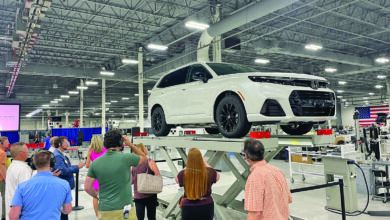12 things Michiganders should know about EVs

It’s easy to get short-circuited by misinformation—and outright lies—about electric vehicles. These are the facts.
MICHIGAN—The state of Michigan has long been the heart of America’s automotive industry, with a legacy rooted in technological innovation, manufacturing prowess, and the relentless drive from several generations of Michigan workers to help put the world on wheels.
And this year, Michigan workers are standing at the precipice of another automotive revolution: the rise of electric vehicles (EVs), which are expected to slowly replace gasoline-powered vehicles as the nation transitions away from fossil fuels and toward cleaner forms of energy that aim to reduce pollution and fight climate change.
But like with any transformative technology, the EV industry has been surrounded by misinformation—particularly from big oil companies worried about losing profits to clean energy.
So, we’re charging ahead with the truth—and plugging in some facts on some of the most common misconceptions that have been short-circuiting across the state of Michigan:
1.) Electric vehicles are way too expensive for the average Michigander.
That was once true but is now increasingly false—and the statistics prove it.
The Chevy Bolt, as just one example, starts at $26,500. With average credit and a 10% down payment, an average monthly payment to finance one at a dealership would be about $420.
That’s significantly lower than the average monthly payment for a new or used car.
(Courtesy/General Motors)
Economists suggest putting no more than 10% of your annual household income toward the purchase of a new vehicle—which is about $6,700 in Michigan. All told, that makes the payment plan above well within the average Michigander’s annual budget, with about $1,700 to spare.
It’s worth noting: Data shows EV prices have declined by about 20% over the last year. But on the whole, they’re still about 15% pricier than the average vehicle. This year, automakers have been in fierce competition to drive down those prices, and at least three manufacturers now reportedly offer long-range EVs for less than the cost of the average new vehicle sold in the US.
It’s worth noting: Although EV prices have come down in recent years, not all EVs are as affordable as the Chevy Bolt. According to Kelley Blue Book, the average EV sells for about $55,242—which would not be considered affordable for the average Michigander’s budget.
Still, a recent analysis found Michiganders (especially F-150 drivers) can save thousands of dollars by ditching their gas-powered cars for newer, electric models—namely by taking advantage of rebates made possible through President Joe Biden’s Inflation Reduction Act.
That federal legislation included tax credits of up to $7,500 for those who buy a new EV. Tax credits of up to $4,000 are also available on certain used models of electric vehicles. And beginning this year, customers can also choose to transfer those tax credits directly to a car dealer, which will effectively lower the purchase price of the EV at the point of sale.
Depending on the model and rebate eligibility, some EV drivers will be able to save more than $20,000 by making the switch from a gasoline- to an electric-powered vehicle, studies show.
2.) The range is way too low to conveniently travel anywhere.
That’s false.
While some older models of electric vehicles weren’t necessarily built for road trips, the average EV had a range of about 270 miles in 2023—which is plenty for the average weekly commute.
Battery technology has only continued to improve since then, including some 2024 models that can now push past 500 miles on a single charge—enough to travel between just about any city in Michigan, including an all-day, across-the-state road trip from Marquette to Detroit.

3.) There aren’t enough chargers.
That’s mostly false. While there definitely aren’t as many EV chargers as gas stations in Michigan, there are now more than 1,400 public charging stations statewide—with more going online every week. This map from the state of Michigan shows just how many are out there.

And unless you’re traveling in the more remote, rural stretches of the state, or venturing deep into the Upper Peninsula, chances are you’ll have easy access to a nearby charging station.
Nationwide, there are nearly 9,200 public fast charging stations now in operation—all of them capable of fully charging an average electric vehicle in about 30 minutes. Michigan is home to more than 300 of those fast chargers, which is up about 52% between 2022 and 2023.
A recent study found that nearly 20% of Michiganders live within 5 minutes of a fast charger.
More than 1,100 slower, Level 2 charging stations—which can fill batteries in 1-2 hours—are also scattered across the state, including at workplaces, retailers, hotels, and restaurants.
With recent state and federal investments from both President Biden and Gov. Gretchen Whitmer designed to help further expand electric vehicle charging infrastructure, millions of new EV chargers are set to continue going online across the state and country in the coming years.
4.) Charging an electric vehicle is too expensive.
This is false.
EPA calculations show that charging your EV—regardless of the make or model—will almost always cost less than filling up your tank with gasoline at the pump. A Washington Post analysis also confirmed that claim by testing several EVs in a variety of environments—and finding that in all 50 states, it’s cheaper for everyday Americans to fill up with electrons instead of gasoline.
It’s worth noting: EVs also typically require less upkeep than gas-powered vehicles—namely because they don’t have an engine that requires oil changes or other mechanical maintenance. As a result, EV drivers are also saving thousands of dollars on routine repairs and service.
5.) Nobody can afford to install an expensive charging station at home.
This one’s a mixed bag.
It’s true that the speediest direct current fast charging stations cost tens of thousands of dollars, and that doesn’t include the cost of hiring an electrician to hook up the equipment. But installing a commercial-grade charger at home is impractical and wholly unnecessary for average drivers.

(Courtesy/City of Phoenix)
All electric vehicles sold in the United States come equipped with a Level 1 charging cord, which can be plugged into a standard, three-prong wall outlet in your garage. These are the slowest chargers on the market, which deliver only about 2-5 miles of range per hour of charging.
State data shows the average weekday commute is less than 13 miles in Michigan. That means by charging overnight with a Level 1 cord, most EV drivers will wake up to enough battery power to handle their daily drive to work—with plenty of spare juice for those longer, weekend drives.
The middle ground is Level 2 charging equipment—which can charge up a battery in 1-2 hours.
Drivers with longer daily commutes (who don’t want to stop at fast chargers along the way) can expect to shell out $500-$1,000 to have a Level 2 station installed in their garage—though rebates are available through utility providers in some Michigan communities, and data shows that at-home chargers can essentially pay for themselves by providing EV drivers with cheaper energy rates, increasing their home values, and eliminating their dependence on gasoline.
It’s worth noting: It’s not always practical (or affordable) for drivers who must park on the street or don’t have access to a wall charger at home—particularly renters—to charge an EV at home.
6.) There aren’t enough American-made EVs. They’re all going to be made in China.
That’s false.
There are plenty of electric vehicles being manufactured stateside, and those companies are expanding their production footprint in the US all the time—largely because of significant investments that were included in the Inflation Reduction Act and other federal legislation.
But the US has lagged behind other countries when it comes to manufacturing EVs and their components. This year, China is expected to produce about 10 million electric vehicles—accounting for about 45% of car sales in the country. And while EV sales are rising in the US, they’re only expected to account for about 11% of all new car sales in 2024.
The president has also enacted a series of tariffs on imports from China—including on EV components—to help discourage the market from being flooded with low-priced exports. Biden has also been a fervent supporter of labor unions (like the United Auto Workers union) in their fight to ensure American workers maintain a role in the global transition to clean energy.
It’s worth noting: Michigan is cementing itself as a powerplayer in the global EV manufacturing game. Recent reports show that dozens of new clean energy or EV-related projects (and at least 20,000 new jobs) have been announced or moved forward in Michigan since the passage of the Inflation Reduction Act—marking more new projects than any other state in the nation.
It’s also worth noting: Michigan has spent $1 billion to support EV and battery plants amid the global race to shore up its signature industry. New jobs, so far, have been slow to materialize.
7.) There’s going to be a federal “mandate” to drive an electric vehicle in the US.
That’s false.
Ahead of the presidential election, ex-President Donald Trump and big oil companies have frequently repeated misinformation about a so-called “ban” on gas-powered cars in the United States and a federal “mandate” led by the Biden administration to drive electric vehicles instead.
Those claims have no bearing in reality.
The Environmental Protection Agency (EPA) cannot mandate the sale of any cars or limit the sale of certain vehicles. That’s just not how the EPA works, nor does it wield that authority.
The agency has proposed new tailpipe emission rules for vehicles, which are designed to reduce pollution. But they do not require automakers to produce EVs in order to meet those emission standards, nor do they require drivers to stop using their gas-powered cars.
8.) Materials used to make EVs rely on shady labor practices and may also pose environmental concerns, depending on how the components are sourced.
That’s true. The EV supply chain has been littered with poor environmental practices—including mineral mining, metal smelting, and battery manufacturing that reportedly generates 35-50% more greenhouse gas emissions than manufacturing conventional, gas-powered vehicles.
But because gas-powered cars produce carbon emissions every time they hit the road, research shows that EVs are still a much more environmentally friendly alternative to gas-powered cars and produce far less pollution.
Still, activists for years have sounded alarms over environmental concerns—and forced labor practices—that have pervaded the industry, particularly among Chinese auto manufacturers.
Biden’s administration, in turn, has fought back against those global concerns by incentivizing more manufacturing stateside, where federal regulations help prevent shady business practices.
9.) Electric vehicle batteries won’t last forever, and they’re expensive to replace.
It’s true, but they’ll still last for a heck of a long time.
The average electric vehicle battery is expected to last for 12-15 years and up to 200,000 miles—which is about the same lifespan as a gasoline-powered transmission.
Those batteries can be fairly expensive to replace, but drivers won’t always have to shoulder the costs. That’s because the vast majority of electric cars sold in the US come with a warranty that includes their batteries and lasts for eight years or 100,000 miles—whichever comes first.
And beginning with 2027 models, new federal regulations will reportedly require all high-voltage battery systems in EVs to carry at least an eight-year—or 80,000-mile—warranty.
It’s worth noting: All EVs—and their batteries—sold in the United States are required to pass the same sorts of safety testing and federal standards as conventional, gas-powered vehicles.
10.) EVs are heavier than gas vehicles, which could wear down Michigan’s roads and bridges. Plus, EV drivers aren’t paying gas taxes to help fix them.
That’s true—but it’s a work in progress.
It’s no secret. Electric vehicles (and their batteries) can be heavy.
Depending on the make and model, electric vehicles can reportedly range anywhere from hundreds to thousands of pounds heavier than similarly sized gas vehicles. The GMC Hummer is often cited as the worst offender; clocking in at more than 9,000 lbs. with a 2,900-lb. battery.
Heavier vehicles, obviously, take a heavier toll on roads and bridges. But studies show that the worst of the damage comes from large semi-trucks—and that more individual EVs on the roadways don’t appear to be significantly heightening the wear and tear on infrastructure. Still, automakers are constantly evolving their technology and striving for more lightweight batteries.
Regardless of the rate of damage, however, EVs are still cruising Michigan’s roads and their drivers aren’t currently paying taxes on gasoline to help support infrastructure repairs. And that inherent inequality has peeved off some gas guzzling taxpayers who are stuck footing the bill.
To help level the playing field, state officials have explored a variety of options that have yet to come to fruition—including increasing registration fees for EVs, adding mileage- or kilowatt-based taxes for road usage, or creating new toll booths on the state’s busier highways.
11.) The electrical grid can’t handle the switch to electric vehicles.
That’s false—or at least that’s what the experts are saying.
First: It’s important to note that the transition to electric vehicles is gradual. The Biden administration is currently gunning for only half of new vehicle sales to be electric by 2030.
Second: Federal data shows that 4.2 trillion kilowatt hours of electricity were generated in the US in 2022. So, even if every vehicle were to convert to battery power tomorrow, the grid would only require a 22% increase in total energy generation to accommodate them, research shows.
Officials at Consumers Energy, which provides electric and natural gas service to nearly 6.5 million of the state’s 10 million residents, have also vouched for the grid’s ability to handle EVs—especially as the state’s power companies continue to beef up their infrastructure.
As automakers ramp up electric vehicle production, Michigan has also invested heavily in energy—including more than $16 million in federal infrastructure funding that was awarded to utilities and power cooperatives last year, specifically to help improve the state’s electric grid.
It’s worth noting: With peak electricity demand, especially in the summer, expected to grow over the coming years, utility companies have said that charging EVs outside of peak hours (like overnight) will be particularly important for ensuring there’s enough power to go around.
It’s also worth noting: Evolving bidirectional charging technology can essentially allow EV batteries to be used for grid storage—meaning some EV drivers can store their own power at home, which can provide backup power for their homes or be sent back to the electric grid.
12.) There aren’t heavy duty trucks that I can use for my job or to tow my camper.
That’s false.
The 2024 F-150 Lightning XLT has a towing capacity of 7,700 lbs. Chevy’s new Silverado EV, with 754 horsepower and 785 foot-pounds of torque, can haul up to 10,000 lbs. Rivian’s newest pickup truck can also tow up to 11,000 lbs. and go from 0-60 mph in less than 3 seconds.
READ MORE: Michigan automakers get federal funds to train local workers for EV jobs
For the latest Michigan news, follow The ‘Gander on Twitter.
Follow Political Correspondent Kyle Kaminski here.




